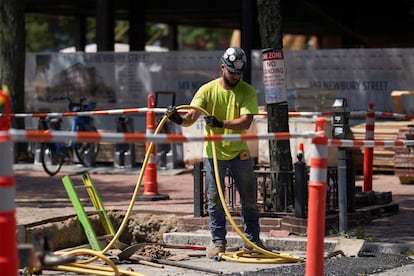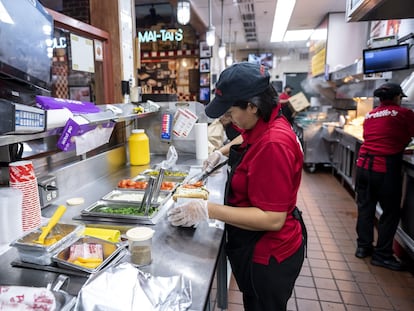Why Americans feel gloomy about the economy despite falling inflation and low unemployment
Many factors lie behind the disconnect, but economists increasingly point to one in particular: the lingering financial and psychological effects of the worst bout of inflation in four decades

Inflation has reached its lowest point in two and a half years. The unemployment rate has stayed below 4% for the longest stretch since the 1960s. And the U.S. economy has repeatedly defied predictions of a coming recession. Yet according to a raft of polls and surveys, most Americans hold a glum view of the economy.
The disparity has led to befuddlement, exasperation and curiosity on social media and in opinion columns.
Last week, the government reported that consumer prices didn’t rise at all from September to October, the latest sign that inflation is steadily cooling from the heights of last year. A separate report showed that while Americans slowed their retail purchases in October from the previous month’s brisk pace, they’re still spending enough to drive economic growth.
Even so, according to a poll last month by The Associated Press-NORC Center for Public Affairs Research, about three-quarters of respondents described the economy as poor. Two-thirds said their expenses have risen. Only one-quarter said their income has.
The disconnect poses a political challenge for President Joe Biden as he gears up for his re-election campaign. Polls consistently show that most Americans disapprove of Biden’s handling of the economy.
Many factors lie behind the disconnect, but economists increasingly point to one in particular: The lingering financial and psychological effects of the worst bout of inflation in four decades. Despite the steady cooling of inflation over the past year, many goods and services are still far pricier than they were just three years ago. Inflation — the rate at which costs are increasing — is slowing. But most prices are high and still rising.
Lisa Cook, a member of the Federal Reserve’s Board of Governors, captured this dynamic in recent remarks at Duke University.
“Most Americans,” Cook said, “are not just looking for disinflation” — a slowdown in price increases. “They’re looking for deflation. They want these prices to be back where they were before the pandemic. ... I hear that from my family.”
That’s particularly true for some of the goods and services that Americans pay for most frequently: Bread, beef and other groceries, apartment rents and utilities. Every week or month, consumers are reminded of how far those prices have risen.
Deflation — a widespread drop in prices — typically makes people and companies reluctant to spend and therefore isn’t desirable. Instead, economists say, the goal is for wages to rise faster than prices so that consumers still come out ahead.
How inflation-adjusted incomes have fared since the pandemic is a complicated question, because it’s difficult for just one metric to capture the experiences of roughly 160 million Americans.
Adjusted for inflation, median weekly earnings — those in the middle of the income distribution — have risen at just a 0.2% annual rate from the final three months of 2019 through the second quarter of this year, according to calculations by Wendy Edelberg, a senior fellow at the Brookings Institution. That meager gain has left many Americans feeling that they have made little financial progress.
For Katherine Charles, a 40-year-old single mother in Tampa, Florida, inflation’s slowdown hasn’t made it easier to make ends meet. Her rent jumped 15% in May. Over the summer, to keep her electricity bill down, Charles kept the air conditioning off during the day despite Tampa’s blistering hot weather.
She has felt the need to cut back on groceries, even though, she said, her 16-year-old son and 10-year-old daughter “are at the age they are eating everything in front of them.”
“My son loves red meat,” Charles said. “We cannot any longer afford it the way we used to. The economy’s not getting better for nobody, especially not for me.”
Charles, a call center representative with a company that handles customer service for the Medicare and Affordable Care Act health plans, received a raise to $18.21 an hour two years ago. But it wasn’t much of an increase. She doesn’t even remember how large it was.
This month, Charles took part in a one-day strike against her employer, Maximus. She and her co-workers are seeking higher wages and more affordable health insurance. Charles’ two children are on Medicaid, she said, because Maximus’ health insurance is too expensive.
Eileen Cassidy Rivera, a spokeswoman for Maximus, said that a recent survey of its 40,000 employees found that three-quarters of those who responded said “they would recommend Maximus as a great place to work.”
“During the past five years, we have increased compensation, reduced out-of-pocket health care expenses and improved the work environment,” Rivera added.
Rising prices have been a key driver of a wave of strikes and other forms of labor activism this year, with unions representing autoworkers, Teamsters and airline pilots winning sizable pay increases.
Other factors also play a role in why many people are still unhappy with the economy. Political partisanship is one of them. With Biden occupying the White House, Republicans are far more likely than Democrats to characterize the economy as poor, according to the University of Michigan’s monthly survey of consumer sentiment.
Karen Dynan, a Harvard economist who served in both the George W. Bush and Obama administrations, noted that distinct swings in economic sentiment occur after a new president is inaugurated, with voters from the party opposed to the president quickly switching to a more negative view.
“The partisan divide is stronger than it was before,” she said. “Partly because the country is more polarized.”
Even so, many Americans, like Charles, are still feeling the pain of inflation. The national average price of a gallon of milk reached $3.93 in October, up 23% since February 2020, just before the pandemic struck. A pound of ground beef, at $5.35, is 33% higher than it was then. Average gas prices, despite a steep decline from a year ago, are still 53% higher at $3.78 a gallon, on average.
All those increases have far outpaced the rise in overall prices, which are up nearly 19% over the same period.
Edelberg said the jump in prices for items that people typically buy most often helps explain why many people are disgruntled about the economy — even as Americans have remained confident enough to keep spending at a healthy pace.
“Their purchasing power overall,” Edelberg said, “is doing pretty well.”
Yet broad national data doesn’t capture the experiences of everyday Americans, many of whom haven’t seen their wages keep up with prices.
“In real terms, most people are probably pretty close to where they were pre-pandemic,” said Brad Hershbein, a senior economist at the Upjohn Institute. “But there are a lot of exceptions.”
Lower-income Americans, for example, have generally received the largest percentage wage gains since the pandemic. Fierce competition for front-line workers at restaurants, hotels, retailers and entertainment venues forced companies to provide significant pay hikes.
But poorer people typically face a higher inflation rate, according to economic research, because they spend a greater proportion of their income on such volatile expenses as food, gas and rent — items that have absorbed some of the biggest price spikes.
“At the lower end of the income distribution, people got somewhat higher pay raises,” said Anthony Murphy, a senior economic policy advisor at the Federal Reserve Bank of Dallas. “But I don’t think it compensates them for the fact that inflation was so much higher. They’re consuming a different bundle of goods than the average.”
Census Bureau surveys that Murphy and his colleague Aparna Jayashankar have studied show that nearly half of Americans say they’re “very stressed” by inflation, little changed from a year earlier, even though inflation has tumbled since last year.
Even for people whose incomes have kept pace with prices, research has long found that people hate inflation more intently than its economic impact would suggest. Most people do not expect their pay to keep up with rising prices. Even if it does, the higher pay may come with a time lag.
“They’re obsessing over the fact that the prices they pay for the things that are very salient — gas, food, grocery store prices, rent — those things still seem elevated, even though they’re not increasing as rapidly as they were,” Hershbein said.
“If everyone had lost a job,” he said, “we’d be focused on that.”
Sign up for our weekly newsletter to get more English-language news coverage from EL PAÍS USA Edition
Tu suscripción se está usando en otro dispositivo
¿Quieres añadir otro usuario a tu suscripción?
Si continúas leyendo en este dispositivo, no se podrá leer en el otro.
FlechaTu suscripción se está usando en otro dispositivo y solo puedes acceder a EL PAÍS desde un dispositivo a la vez.
Si quieres compartir tu cuenta, cambia tu suscripción a la modalidad Premium, así podrás añadir otro usuario. Cada uno accederá con su propia cuenta de email, lo que os permitirá personalizar vuestra experiencia en EL PAÍS.
¿Tienes una suscripción de empresa? Accede aquí para contratar más cuentas.
En el caso de no saber quién está usando tu cuenta, te recomendamos cambiar tu contraseña aquí.
Si decides continuar compartiendo tu cuenta, este mensaje se mostrará en tu dispositivo y en el de la otra persona que está usando tu cuenta de forma indefinida, afectando a tu experiencia de lectura. Puedes consultar aquí los términos y condiciones de la suscripción digital.
More information
Últimas noticias
Most viewed
- Sinaloa Cartel war is taking its toll on Los Chapitos
- Oona Chaplin: ‘I told James Cameron that I was living in a treehouse and starting a permaculture project with a friend’
- Reinhard Genzel, Nobel laureate in physics: ‘One-minute videos will never give you the truth’
- Why the price of coffee has skyrocketed: from Brazilian plantations to specialty coffee houses
- Silver prices are going crazy: This is what’s fueling the rally










































